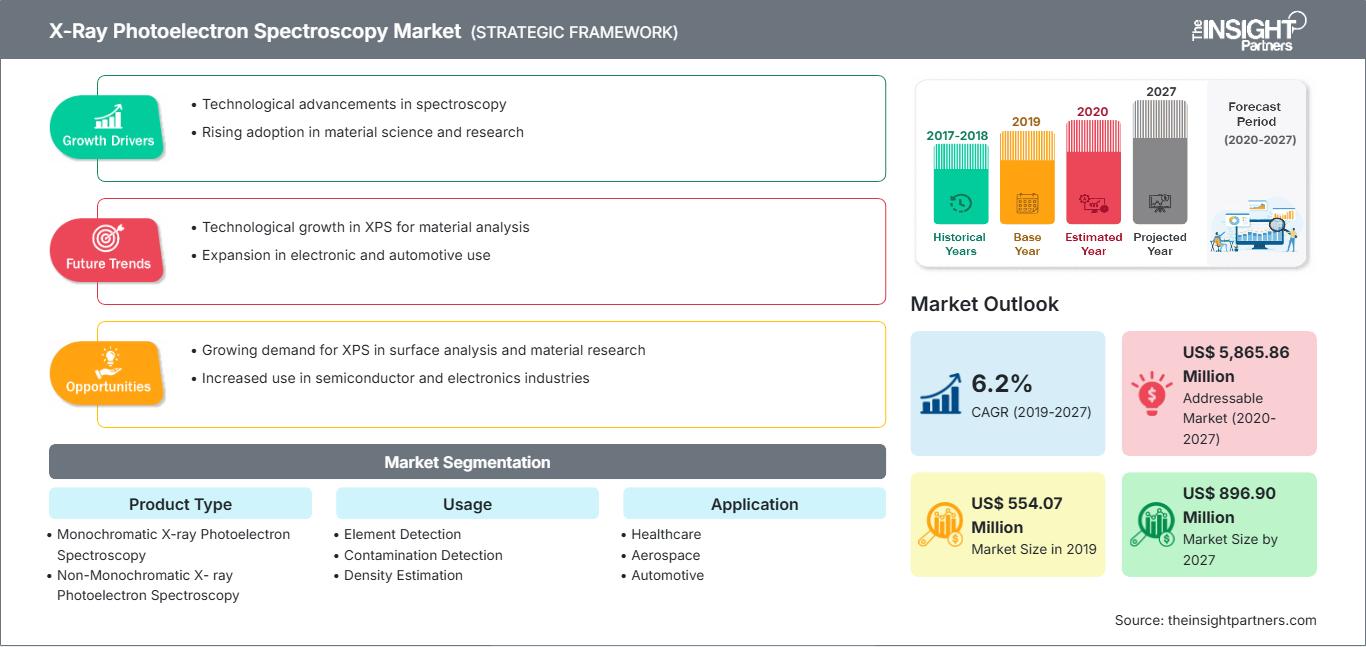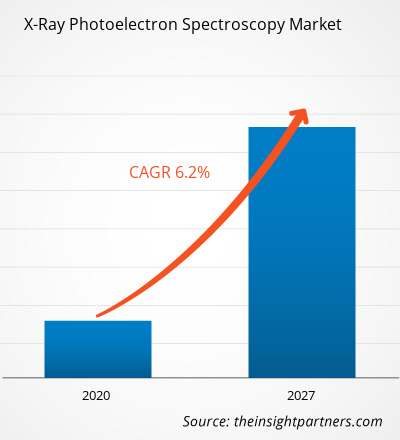X선 광전자 분광법 시장은 2019년 5억 5,407만 달러 규모였으며, 2020년부터 2027년까지 연평균 성장률(CAGR) 6.2%로 성장하여 2027년에는 8억 9,690만 달러에 이를 것으로 예상됩니다.
X선 광전자 분광법(XPS)은 주어진 시료 내 존재하는 원소의 원소 구성, 실험식, 화학적 상태 및 전자 상태를 측정하는 데 사용되는 정량 분광 기술입니다. 글로벌 X선 광전자 분광법 시장은 고성능 소재 수요 증가 및 민간 기관의 R&D 자금 지원 증가 등의 요인에 의해 주도되고 있지만, 숙련된 전문가 부족으로 인해 예측 기간 동안 시장 성장이 저해될 것으로 예상됩니다. 그러나 신흥국의 개발 기회는 가까운 미래에 업계 참여자들의 시장 점유율을 향상시킬 수 있는 상당한 성장 기회를 제공할 것으로 예상됩니다.
시장 분석: 고성능 소재에 대한 수요 증가
X선 광전자 분광법(XPS)은 재료의 표면 화학을 분석하는 데 사용되는 기술입니다. XPS 기술은 화학 분석을 위한 전자 분광법(ESCA)으로도 알려져 있으며, 재료 표면의 화학적 특성을 분석하는 데 널리 정립된 방법입니다. 산업용 및 상업용 섬유 공급업체와 제조업체는 소비자가 요구하는 표면 코팅 또는 처리 유형의 최적화 및 개발을 지원하는 이상적인 도구로서 XPS 개발에 주력하고 있습니다. 폴리에스터 및 폴리프로필렌과 같은 폴리머 메시는 탈장 및 기타 연조직 결손의 외과적 복구에 사용됩니다.
요구 사항에 맞게 이 보고서를 사용자 정의하십시오.
이 보고서의 일부, 국가 수준 분석, Excel 데이터 팩을 포함하여 모든 보고서에 대한 사용자 정의를 무료로 받을 수 있을 뿐만 아니라 스타트업 및 대학을 위한 훌륭한 제안 및 할인을 이용할 수 있습니다
X선 광전자 분광법 시장: 전략적 통찰력

-
이 보고서의 주요 주요 시장 동향을 확인하세요.이 무료 샘플에는 시장 동향부터 추정 및 예측에 이르기까지 데이터 분석이 포함됩니다.
수술에 메시 소재를 사용하지만, 메시 소재의 이식은 심각한 감염률과 관련이 있을 수 있습니다. 이러한 메시의 감염률을 낮추려면 표면 특성을 개선해야 합니다. 또한, 현대 재료와 관련된 많은 문제는 재료 층 또는 표면 계면에서 발생하는 화학적 및 물리적 상호작용을 이해함으로써 해결할 수 있습니다. 표면은 촉매 활성, 부식 속도, 습윤성, 접착력, 접촉 전위 및 파손 메커니즘과 같은 요인에 영향을 미칩니다. 따라서 고성능 소재에 대한 수요 증가는 예측 기간 동안 X선 광전자 분광법 시장 규모를 비례적으로 증가시킬 것입니다.
제품 유형 분석
X선 광전자 분광법 시장의 제품 유형 세그먼트에는 단색 X선 광전자 분광법과 비단색 X선 광전자 분광법이 포함됩니다. 단색 X선 광전자 분광법 부문은 세계 X선 광전자 분광법 시장에서 가장 큰 점유율을 차지했습니다. 단색 X선 광전자 분광법은 다양한 시료를 분석할 수 있는 알루미늄 단색 X선 광원을 사용합니다. 단색 분광기를 사용하면 X선 광원과 시료 사이의 거리가 비단색 X선 광원을 사용할 때보다 넓어 시료 손상 위험이 줄어듭니다. 따라서 단색 X선 광전자 분광법은 비단색 X선 광전자 분광법에 비해 많은 장점을 제공합니다.
사용 정보
X선 광전자 분광법 시장의 사용 분야에는 원소 검출, 밀도 추정, 오염 물질 검출, 실험식 결정 등이 있습니다. 원소 검출 시장은 2019년에 가장 높은 점유율을 기록했으며, 다양한 분야의 다양한 응용 분야로 인해 예측 기간 동안 주목할 만한 성장을 보일 것으로 예상됩니다.
시장 점유율 측면에서 오염 검출은 사용 부문에서 두 번째를 차지합니다. XPS를 사용하여 유기 및 무기 오염 물질을 검출할 수 있습니다. 복합 금속, 유리, 기체 및 강하게 흡수된 액체의 표면 분석은 XPS 응용 분야를 통해 수행할 수 있습니다.
응용 분야 분석
본 연구의 응용 분야는 의료, 항공우주, 자동차 및 기타입니다. 의료 시장 응용 분야에는 세포/박테리아/조직 분석, 화학물질 특성 분석, 항체 고정화, 단백질 및 펩타이드 연구가 포함됩니다. 전자 시장에서 XPS는 성분 분석 및 특성 분석에 사용됩니다. 항공우주, 자동차 및 포장 시장에서 XPS는 표면 필름 분석에 사용됩니다.
의료 분야는 응용 분야에서 가장 큰 시장 점유율을 차지했으며 예측 기간 동안 시장을 주도할 것으로 예상됩니다. 높은 점유율은 의료용 임플란트의 투약 오류 최소화 및 오염 물질 허용 기준에 대한 엄격한 규정 덕분입니다.
기업들은 전 세계적으로 사업 영역을 확장하고 증가하는 수요를 충족하기 위해 인수합병 전략을 일반적으로 채택합니다. 이 전략은 시장 참여자들이 제품 포트폴리오를 강화하기 위해 가장 일반적으로 채택합니다.
X선 광전자 분광법 시장에서 활동하는 시장 참여자들은 전 세계 고객 기반을 확대하기 위해 연구 개발에 대한 확장 및 투자 전략을 채택하며, 이를 통해 전 세계적으로 브랜드 인지도를 유지할 수 있습니다.
X선 광전자 분광법 시장 지역별 통찰력
The Insight Partners의 분석가들은 예측 기간 동안 X선 광전자 분광법 시장에 영향을 미치는 지역별 동향과 요인을 자세히 설명했습니다. 이 섹션에서는 북미, 유럽, 아시아 태평양, 중동 및 아프리카, 그리고 중남미 지역의 X선 광전자 분광법 시장 부문 및 지역별 분포도 살펴봅니다.
X선 광전자 분광법 시장 보고서 범위
| 보고서 속성 | 세부 |
|---|---|
| 시장 규모 2019 | US$ 554.07 Million |
| 시장규모별 2027 | US$ 896.90 Million |
| 글로벌 CAGR (2019 - 2027) | 6.2% |
| 이전 데이터 | 2017-2018 |
| 예측 기간 | 2020-2027 |
| 다루는 세그먼트 |
By 제품 유형
|
| 포함된 지역 및 국가 |
북미
|
| 시장 선도 기업 및 주요 회사 프로필 |
|
X선 광전자 분광법 시장 참여자 밀도: 비즈니스 역학에 미치는 영향 이해
X선 광전자 분광학 시장은 소비자 선호도 변화, 기술 발전, 그리고 제품 이점에 대한 인식 제고 등의 요인으로 인한 최종 사용자 수요 증가에 힘입어 빠르게 성장하고 있습니다. 수요가 증가함에 따라 기업들은 제품 및 서비스 확장, 소비자 니즈 충족을 위한 혁신, 그리고 새로운 트렌드를 적극 활용하고 있으며, 이는 시장 성장을 더욱 가속화하고 있습니다.

- 을 얻으세요 X선 광전자 분광법 시장 주요 주요 플레이어 개요
글로벌 X선 광전자 분광법 시장 - 제품 유형별
- 단색 X선 광전자 분광법
- 비단색 X선 광전자 분광법
글로벌 X선 광전자 분광법 시장 - 용도별
- 원소 검출
- 오염 검출
- 경험적 공식 결정
- 밀도 추정
- 기타
글로벌 X선 광전자 분광법 시장 - 응용 분야별
- 헬스케어
- 항공우주
- 자동차
- 기타
X선 광전자 분광법 시장 - 지역별
-
북미
- 미국
- 캐나다
- 멕시코
-
유럽
- 프랑스
- 독일
- 이탈리아
- 영국
- 러시아
- 유럽의 나머지 지역
-
아시아 태평양
- 중국
- 인도
- 한국
- 일본
- 호주
- 아시아 태평양의 나머지 지역
-
중동 및 아프리카
- 남아프리카공화국
- 사우디아라비아
- UAE
- 중동 및 아프리카 기타 지역
-
남아메리카
- 브라질
- 아르헨티나
- 남아메리카 기타 지역
회사 프로필
- 시마즈 주식회사
- Physical Electronics, Inc.
- Thermo Fisher Scientific Inc
- Japan Electron Optics Laboratory Company, Limited
- Revera Inc.
- SPECS GmbH
- PREVAC
- Scienta Omicron
- Staib Instruments
- OCI Vacuum Microengineering Inc.
- 과거 분석(2년), 기준 연도, CAGR을 포함한 예측(7년)
- PEST 및 SWOT 분석
- 시장 규모 가치/거래량 - 글로벌, 지역, 국가
- 산업 및 경쟁 환경
- Excel 데이터세트
최근 보고서
관련 보고서
사용 후기
구매 이유
- 정보에 기반한 의사 결정
- 시장 역학 이해
- 경쟁 분석
- 고객 인사이트
- 시장 예측
- 위험 완화
- 전략 기획
- 투자 타당성 분석
- 신흥 시장 파악
- 마케팅 전략 강화
- 운영 효율성 향상
- 규제 동향에 발맞춰 대응






















 무료 샘플 받기 - X선 광전자 분광법 시장
무료 샘플 받기 - X선 광전자 분광법 시장